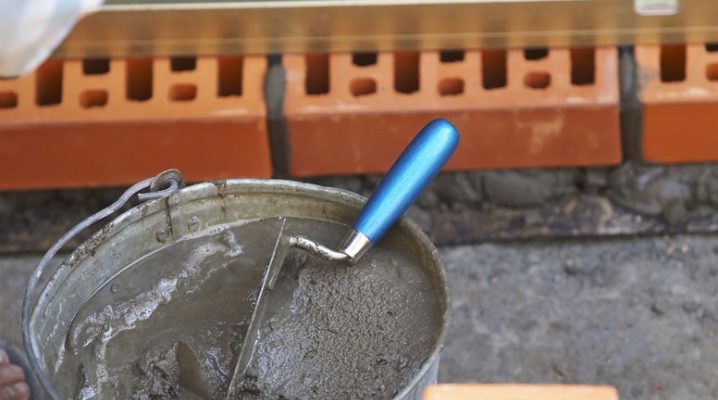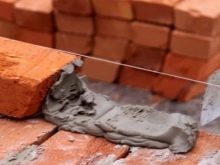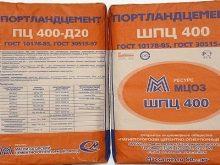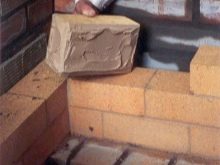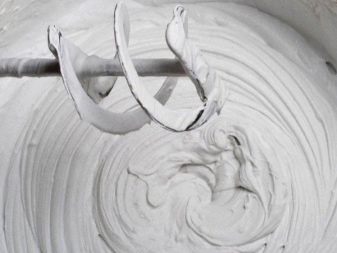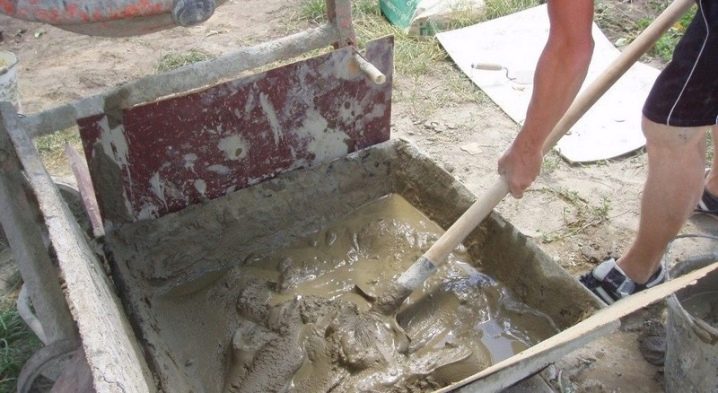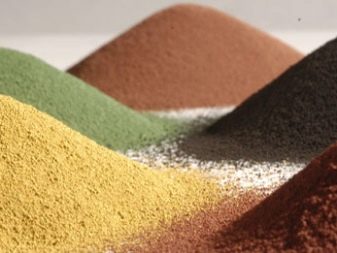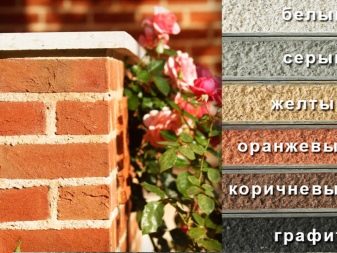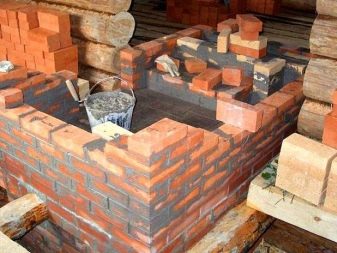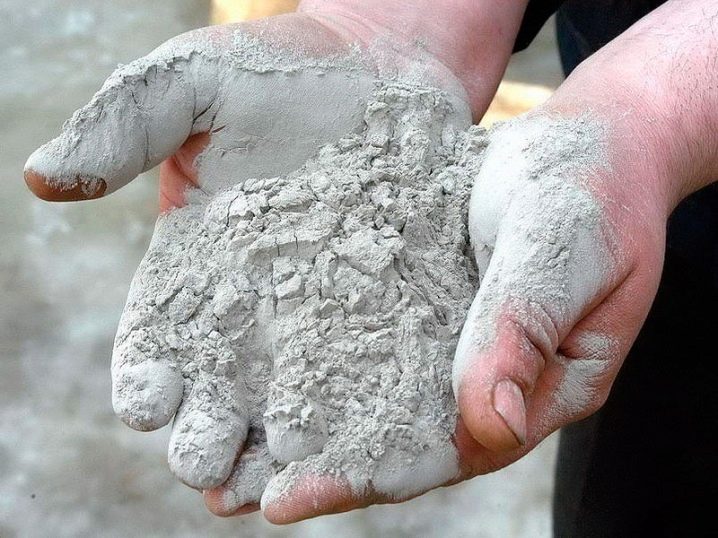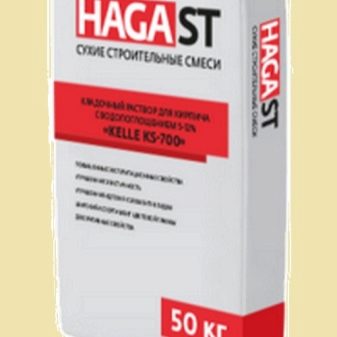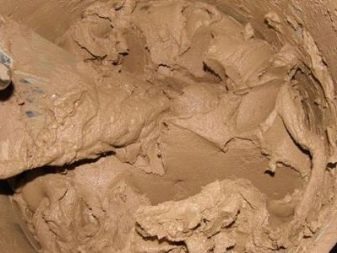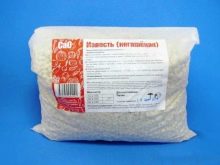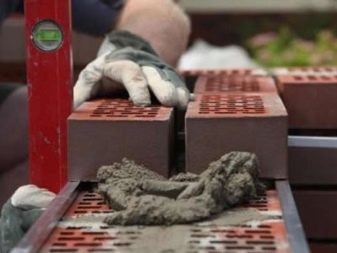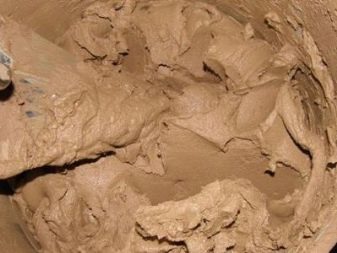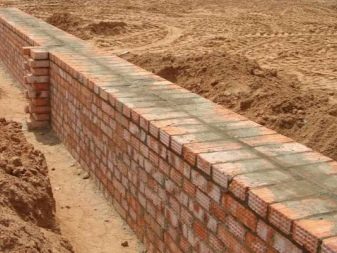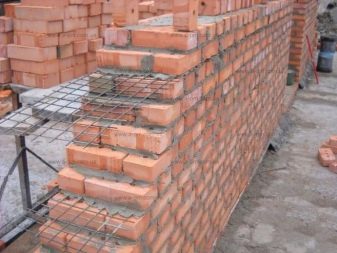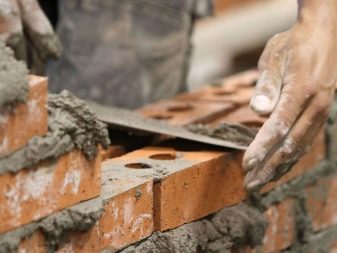Properties of mortar for brick laying and technology of their preparation
Before you decide on the issue of laying, first of all you should carefully evaluate your budget, because it’s one thing to buy bricks and quite another to choose masonry mix. It may be more expensive than the bricks themselves. Often people choose the cheapest option, but it is not always suitable. To choose a solution for your needs, you should learn more about the types of mixtures, how they differ, what are their pros and cons.
Types of masonry mortars
There are several options for masonry mixes. The most commonly used cement-based solution, which is also called sand-cement. In addition to brickwork, it is perfect for rough plaster, as well as for concrete floor screed.It all depends on the consistency. A thicker mortar will be suitable for masonry, it will not spread during work and will not leave smudges, and the masonry will be even and neat, the bricks will not move.
The cement mortar has quite a few minuses; its strength is the main one. The mixture after drying has a high rigidity, in the process of shrinkage of the structure, in which the frame is made of concrete, or thermal expansion masonry may burst, thereby reducing the strength of the structure.
Often brickwork on cement mortar requires insulation.
Cement mortar is characterized by low mobility, which is not very well manifested in the process of building masonry. The mobility of the mixture is determined by the factor of its spreading over the surface under its own weight. Motility can be reduced or increased by adding mixture components. This property allows you to fill the vertical and horizontal seams evenly.
Lime mortar, unlike cement, is more plastic and warm. But it is much less durable and therefore it is rarely used for masonry walls, which carry a large load, more intended for low-rise buildings.It is used mainly in dry rooms. Calcareous mixtures dry longer, which increases the time from laying to finishing work. Such solutions are rarely recommended.
Cement-lime mortar is a kind of golden mean. It is quite durable, ductile and warm, which allows it to be used for almost all types of masonry. It is easy to apply, which increases the speed of work. Suitable for building walls in dry and wet areas. Maintains the big loading and approaches as the bearing designs.
Along with the above, often used cement-clay mortar, it seizes faster cement-lime. Great for use in areas with low temperatures. It has sufficient ductility and strength.
It is usually used as an alternative to cement-lime.
In addition, commercially available dry mixes are available, which simply need to be diluted with water in the right proportions. They have all the necessary properties that are appropriate for different types of masonry. Such mixtures are much easier to use, but their price can be much higher than the cost of the same amount of solution,cooked on their own.
Among the ready-made solutions can be found colored masonry mixture. They are designed for decorative brickwork, but have an adequate margin of safety and protect the masonry from damage. Such mixtures are resistant to frost and moisture, as are often used for cladding buildings. The market offers a large selection of colors and shades of the mixture, you can easily choose it for any needs.
A color mixture can have two uses. In one of the variants, a monochrome shade is necessary and the mixture should not stand out against the general background of the masonry, therefore it is selected for the basic color of the brick. In another embodiment, it is necessary to distinguish the structure of the brickwork and the color of the solution is chosen contrasting. In such cases, a white solution is often used. There is an opportunity to choose the color for any needs.
There are still heat-resistant mixture. They are used for laying stoves, fireplaces and chimneys. Such solutions do not deform when heated and do not lose their properties.
Production of any type of stone stoves, as well as chimney pipes, is recommended only with the help of heat-resistant solutions.Together with heat-resistant bricks, they form a durable structure, which will be much less fire-hazardous.
Composition and proportions
The proportions of any types of solutions are calculated based on the load that will be on them. The cement mortar contains cement and, as a rule, quarry sand. It initially contains a small percentage of clay, which adds plasticity to the solution. River sand is not suitable for these purposes due to its coarse fraction and a large amount of impurities - it has to be carefully filtered. Cement acts as a binding element, the more its result will be, the stronger the result will be after drying. It is also influenced by the brand and the freshness of the cement. Over time, unused cement tends to deteriorate.
For masonry, the ratio of cement and sand should be 1/3. Since the mortar is suitable not only for masonry, the proportion can vary from 1/3 to 1/6, depending on the type of work.
Lime mortars consist of quicklime ground lime or lime paste, sand and water. The optimum proportion is from 1/2 to 1/5 of lime to sand, depending on the fat content of lime.
Cement-lime mortars consist of cement, slaked lime, sand and water. As a rule, proportions are observed 1/1/6 (cement, lime and sand). The recipe for this solution is quite simple, it is prepared according to the same principle as lime. Such solutions can be used for plastering.
The composition of the finished masonry mortar may be different depending on the type of material from which the brick is made. Basically it consists of a binder, which can be cement or lime, and also includes a filler and a plasticizer - they are often sand and clay. In some cases, as part of the mixtures, there may be special additives to increase the speed of drying or frost-resistant to work at low temperatures.
Proportions, as a rule, are indicated on the package in the ratio of water and the mixture itself. In the production of such mixtures all the ingredients are brought to a homogeneous mass, ground and packaged in packages. The consumer can only follow the instructions.
To obtain colored solutions in the mixture add the necessary mineral pigment. They are not subject to fading. Mix can be ordered on request.Otherwise, these solutions differ from the previous ones only in their value.
Heat-resistant mixtures are based on cement, lime or clay. In some cases, the foundation may be gypsum. Have a number of special additives, the cost of which may be too high for self-preparation of the solution.
Due to the high cost of ready-made mixtures, often there is a task to prepare them yourself. for heat-resistant solutions, the components can be sand and clay. Clay is resistant to high temperatures. The main criterion is its fat content, the use of lean clay is contraindicated, the excess fat content can be compensated by sand. From this type of mixture should lay the body of the furnace. Facing is better to produce a solution on a cement base or lime. Use of color masonry mix is allowed.
Limestone masonry implies the presence of asbestos as a reinforcing material. It is known for its heat resistance.
Manufacturing technology
To prepare a solution for brickwork is usually not difficult. Basically, all components are commercially available. The easiest way is to prepare a cement mortar.In appropriate proportions, the mixture is brought to a homogeneous composition, after which it is necessary to dilute it with water and mix to a viscous state. It is important not to pour water too much, as the mixture will turn out too liquid, which will complicate the process of laying and will leave smudges. In addition, the liquid solution will reduce the strength of the structure.
Lime mortar is prepared on the basis of lime dough, which can be prepared independently from quicklime or buy ready-made. To prepare in the above proportions knead the lime dough and sand. After that, dilute all with water. It is important to choose the right consistency, it should resemble sour cream in thickness.
Cement-lime mortars are prepared according to the same principle. The difference is in the presence of cement in the composition.
For the preparation of clay solutions it is necessary to check the fat content of the clay. To do this, it is necessary to dilute the clay with water and mix it with a smooth plate until the consistency of sour cream, and then estimate the amount of clay remaining on the plate after removing it from the solution. If the clay layer is too thin, about 1 mm, then it is considered thin and unsuitable for laying.
Thick layer means that the clay is too greasy, it should be diluted with sand in larger quantities than usual. The clay is considered optimal if its thickness on the plate will be 3-5 mm with small clots. Clay mixed with sand, diluted with water to the consistency of sour cream and then ready to go.
Consumption
The consumption rates of masonry mortars are calculated based on the thickness of the erected walls, the size and type of brick. Solid brick will require a smaller amount of mortar than hollow brick. And also on the walls of brick, which has large sizes (one and a half, double), will require a smaller amount of mortar than on the same wall of single brick. Consumption is usually calculated on 1 square. m and 1 cu. m
Consider an example with a cement mortar. If we talk about the thickness of the wall, then there are several types of masonry:
- in half-brick;
- in one brick;
- in two bricks;
- two and a half bricks.
Standard single brick has a size of 250x120x65 mm. In one cubic meter they fit about 400 pieces. Using a brick of this size, with a seam thickness of 1 cm, approximately 0.3 cu. m solution, given a small margin. In terms of 1 square.m brickwork volume will be about 75 liters of mortar. With deduction of water, which, as a rule, makes up 25–35% of the total amount of the solution, it can be calculated that the consumption of cement per 1 sq. M. m laying will average 33 kg.
In accordance with the proportions 1/3 of the sand will need about 100 kg. The amount of spent building material may vary depending on the source components from which the brick was made.
Different types of bricks are distinguished by their ability to absorb moisture, which in various cases can increase or decrease material costs.
At the moment there are online calculators that will help make a more accurate calculation. And also in any hardware store will provide full advice on the consumption of a mixture. It will not be superfluous to take advice from a professional bricklayer. A good specialist will clarify a large number of aspects related to masonry. Manufacturers of bulk materials always indicate consumption on the packaging of their products. It is recommended to buy components of the mixture with a margin, since the construction is full of unforeseen situations.
For tips on how to mix brick mortar, see the next video.
